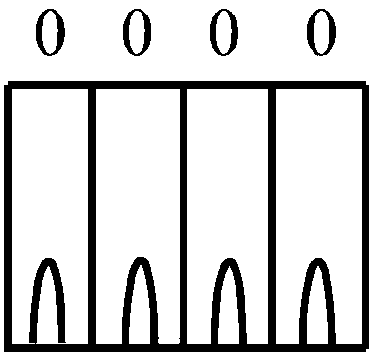HD-QKD system based on polarization modulation time coding
A technology of polarization modulation and time coding, applied in transmission systems, digital transmission systems, and key distribution, which can solve the problems of positive correlation between complexity and dimension, constraints on high-dimensional time coding QKD systems, and increased complexity of X-based vector measurement devices , to achieve the effect of improving measurement efficiency
- Summary
- Abstract
- Description
- Claims
- Application Information
AI Technical Summary
Problems solved by technology
Method used
Image
Examples
Embodiment 1
[0162] see Figure 11 In this embodiment, the modulation of the base vector and the decoy state adopts an internal modulation method, which is completed by a polarization pulse group generating device, including:
[0163] 1. Use Figure 6 The polarized pulse group generating device shown generates a polarized pulse group;
[0164] 2. Through internal modulation, the output pulse group completes the modulation of the base vector and the decoy state (see below);
[0165] 3. The modulated pulse group sequence is transmitted to the measurement end through optical fiber;
[0166] 4. The pulse group sequence is first split by the beam splitter BS, and its transmission and reflection ratios are just the probability ratio of Z and X base vector modulation;
[0167] 5. The transmission pulse enters the Z base vector measuring device; preferably, the Z base vector measuring device selects one of the structures shown in Figure 7;
[0168] 6. The reflected pulse enters the X base vect...
Embodiment 2
[0175] see Figure 14 , compared with embodiment 1, this embodiment realizes the modulation of the decoy state through the form of external modulation; short pulse drive voltage V 0 To achieve, but through an external modulator to achieve.
[0176] Preferably, the decoy state modulation means is an intensity modulator;
[0177] Preferably, the decoy state modulation device is an intensity modulation device composed of a beam splitter and a phase modulator, such as Figure 15 As shown; the pulse is incident through port 1 of the balanced beam splitter (BS), and the pulse with the required intensity can be obtained through interference at port 2 of the BS by adjusting the modulation phase of the phase modulator (PM).
[0178] The rest of the device and the steps are the same as in Example 1.
Embodiment 3
[0180] see Figure 5 , compared with Embodiment 2, the modulation of the base vector in this embodiment is also performed in the form of external modulation; Figure 6 The driving voltage of the light injected into the polarized pulse group generating device is as follows Figure 16 As shown; the device generates polarization-modulated pulse groups: pulses with the same intensity in four time intervals, and the phase of each pulse is the same.
[0181] The base vector modulation device consists of Figure 15 The shown intensity modulation device and phase modulator are composed;
[0182] The decoy state modulation device is Figure 15 structure shown.
[0183] The rest of the device and the steps are the same as in Example 1.
PUM
 Login to View More
Login to View More Abstract
Description
Claims
Application Information
 Login to View More
Login to View More - R&D
- Intellectual Property
- Life Sciences
- Materials
- Tech Scout
- Unparalleled Data Quality
- Higher Quality Content
- 60% Fewer Hallucinations
Browse by: Latest US Patents, China's latest patents, Technical Efficacy Thesaurus, Application Domain, Technology Topic, Popular Technical Reports.
© 2025 PatSnap. All rights reserved.Legal|Privacy policy|Modern Slavery Act Transparency Statement|Sitemap|About US| Contact US: help@patsnap.com



